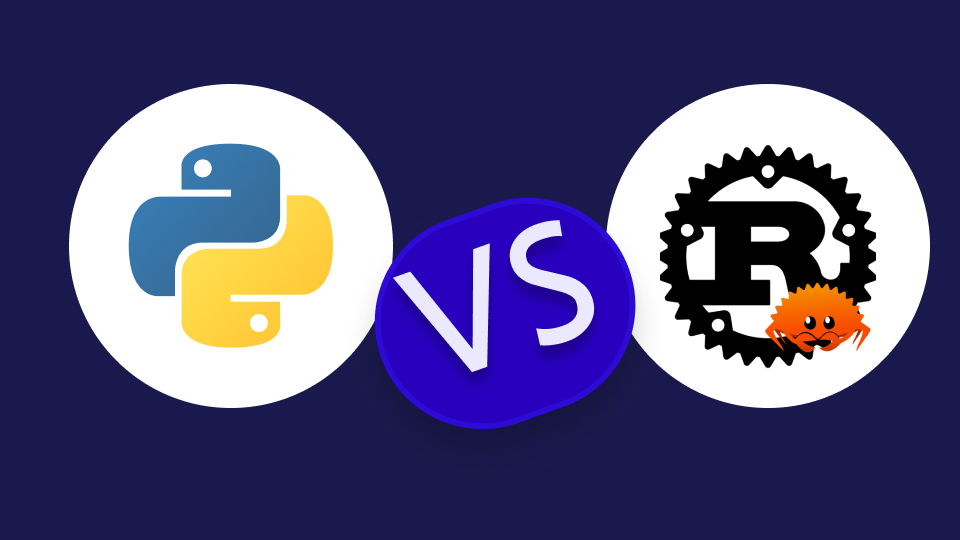Rust vs Python: Will Rust Be Python's Successor?
 Muhammad Fiaz
Muhammad FiazTable of contents

In the ever-evolving world of programming languages, two titans stand out: Rust and Python. Both languages empower developers to create incredible applications, but they cater to distinct needs and possess unique strengths and weaknesses. This comprehensive guide delves into a head-to-head comparison of Rust and Python, exploring their functionalities, ideal use cases, and potential roles in the ever-evolving programming landscape.
Understanding the Core Differences: A Deep Dive
When choosing the right language for a project, a thorough understanding of its core functionalities is crucial. Here's a detailed breakdown of Rust and Python across key aspects:
Speed and Performance:
Rust: Blazingly fast due to its compiled nature. Compiled code translates directly to machine code, resulting in near-native performance, making it ideal for real-time applications and computationally intensive tasks.
Python: An interpreted language, meaning the code is executed line by line during runtime. While slower than Rust, Python offers acceptable performance for many use cases.
Memory Management:
Rust: Employs manual memory management. Developers have fine-grained control over memory allocation and deallocation, ensuring memory safety and preventing memory leaks. However, this requires a deeper understanding of memory management concepts.
Python: Features automatic garbage collection. The interpreter handles memory management automatically, simplifying development but potentially leading to performance overhead.
Concurrency:
Rust: Provides powerful features for safe and efficient multi-threading. This is crucial for applications that need to handle multiple tasks simultaneously, making it well-suited for high-performance computing and server-side development.
- Python: Offers limited support for concurrency. While libraries like
threadingexist, managing concurrency in Python can be challenging compared to Rust's built-in capabilities.
- Python: Offers limited support for concurrency. While libraries like
Learning Curve:
Rust: Steeper learning curve due to its ownership system and focus on memory management. Grasping these concepts requires more effort from beginners.
- Python: Easier to learn with simpler syntax and a focus on readability. Python's beginner-friendliness makes it a popular choice for introductory programming courses and rapid prototyping.
Applications:
Rust: Systems programming (operating systems, kernels), embedded systems, game development, high-performance web servers, and applications demanding real-time responsiveness.
- Python: Data science, machine learning, web development (backend and scripting), automation tasks, and general-purpose scripting due to its extensive libraries and frameworks.
| Aspect | Rust | Python |
| Speed and Performance | Blazingly fast due to compiled nature | Interpreted language, slower execution |
| Memory Management | Manual memory management (enforces safety) | Automatic garbage collection |
| Concurrency | Powerful features for safe and efficient multi-threading | Limited support for concurrency |
| Learning Curve | Steeper learning curve due to ownership system | Easier to learn for beginners with simpler syntax |
| Applications | Systems programming, game development, high-performance applications | Data science, machine learning, scripting, web development |
Choosing the Right Tool for the Job: When to Use Rust vs. Python
The best language for your project depends on its specific requirements. Here's a simplified guideline:
Choose Rust if: Performance, memory safety, and fine-grained control are paramount. You're developing low-level systems, embedded systems, or applications requiring real-time responsiveness.
Choose Python if: Rapid development, data analysis, scripting tasks, or machine learning are your focus. You value ease of use and a vast ecosystem of libraries and frameworks readily available.
Will Rust Succeed Python?
While Rust's rise is undeniable, it's unlikely to completely replace Python in the near future. Here's why:
Python's Established Ecosystem: Python boasts a vast collection of mature libraries and frameworks, along with a well-established community, making it a well-oiled machine for specific tasks.
Ease of Use: Python's readability and beginner-friendliness make it a gateway language for many programmers, fostering a large and active user base.
Domain Specificity: Python reigns supreme in data science and machine learning, where its libraries like NumPy and TensorFlow are deeply entrenched and widely used.
The Future of Programming Languages: A Multifaceted Landscape
Instead of a single language dominating the scene, the future of programming is likely to be a multi-language landscape. Languages like Rust and Python will co-exist, with developers choosing the best tool based on their project's specific needs and requirements.
Rust's Potential for Growth:
Increased Adoption: As performance and security become even more critical considerations, Rust might see broader adoption in web development and backend systems.
Evolving Ecosystem: The Rust community is actively developing new libraries and frameworks, making them more accessible and versatile for various use cases.
Focus on Safety and Security: With growing concerns about cyber threats, Rust's focus on memory safety makes it a compelling choice for security-critical applications.
Areas of Usage: Rust vs Python
Here's a breakdown of areas where Rust and Python are shaping the future of programming, highlighting their unique strengths and potential:
Rust:
Systems Programming: Rust's focus on performance, memory safety, and concurrency makes it a natural fit for low-level systems programming tasks. It's increasingly being used for developing operating system kernels, device drivers, and embedded systems, where reliability and efficiency are paramount.
Web Development: Frameworks like Rocket and Actix are leveraging Rust's speed and memory safety to create high-performance web servers and backend applications. The ability to handle concurrency efficiently makes it suitable for microservices architectures where multiple independent services need to communicate seamlessly.
Game Development: Game engines like Amethyst and Fyrox are utilizing Rust's speed and memory safety to create performant and robust game development environments. Eliminating the possibility of memory leaks and crashes enhances game stability and user experience.
High-Performance Computing: Rust's exceptional performance and ability to handle parallel processing efficiently makes it well-suited for computationally intensive tasks in scientific computing, simulations, and machine learning.
Python:
Data Science and Machine Learning: Python's vast ecosystem of libraries like NumPy, Scikit-learn, and TensorFlow makes it the de-facto language for data science and machine learning. These libraries provide powerful tools for data manipulation, analysis, and model building, making Python accessible to both researchers and data scientists.
Artificial Intelligence (AI): While not as prominent as in machine learning, Python's ease of use and extensive libraries like PyTorch and TensorFlow Lite are being used for developing and deploying AI applications, especially in areas like natural language processing and computer vision.
Automation and Scripting: Python's simplicity and readability make it a popular choice for automating repetitive tasks, creating scripts for system administration, and building DevOps tools. Its integration with various operating systems allows for easy deployment and execution of automated tasks.
Web Development (Backend): While not as dominant for high-performance web applications as some newer languages, Python frameworks like Django and Flask provide a robust and efficient foundation for building web applications with clear and concise code.
Conclusion: A Cohesive Programming Future
Both Rust and Python are valuable languages with distinct strengths and weaknesses. While Rust boasts impressive speed, memory safety, and fine-grained control, its steeper learning curve and evolving ecosystem might deter beginners. Python, on the other hand, excels in readability, ease of use, and a vast collection of established libraries, making it a favorite for rapid development and data science tasks.
The future of programming languages is unlikely to be a single dominant force. Instead, we'll likely see a multi-language landscape where Rust and Python co-exist. Developers will choose the language that best suits their project's specific needs, whether it's prioritizing raw performance and security with Rust, or leveraging Python's extensive ecosystem for rapid development and data analysis.
Here are some additional points you can consider including in your conclusion:
The ongoing advancements in the Rust ecosystem, with new libraries and frameworks constantly emerging.
The potential for Rust to gain wider adoption in web development and backend systems as performance and security become even more critical considerations.
The importance of understanding the strengths and weaknesses of each language to make informed decisions when choosing the right tool for the job.
By fostering a deeper understanding of both Rust and Python, developers can equip themselves to navigate the ever-evolving programming landscape and create innovative solutions for the future.
Reference:
https://www.rust-lang.org/: The official website for the Rust programming language. It contains comprehensive documentation, tutorials, and information about the language's features and philosophy.
https://doc.rust-lang.org/book/: "The Rust Programming Book" is a comprehensive free online book that covers all aspects of the Rust language, from basic syntax to advanced topics.
https://docs.python.org/: The official documentation for the Python programming language. It provides detailed information about the language's syntax, libraries, and best practices.
https://crowdbotics.com/posts/blog/python-vs-rust-which-is-better/: This article on Better Programming dives into the key differences between Rust and Python and explores use cases for each language.
https://deavid.wordpress.com/2021/02/06/rust-vs-python-rust-will-not-replace-python/: This article from Kinsta compares Rust and Python in detail, highlighting their strengths and weaknesses, and discusses the potential future of both languages.
I hope this helps!
follow me for more updates!
Subscribe to my newsletter
Read articles from Muhammad Fiaz directly inside your inbox. Subscribe to the newsletter, and don't miss out.
Written by

Muhammad Fiaz
Muhammad Fiaz
Open Source Contributor ✨ and Maintainer 🔥| Full Stack Developer 🧑💻